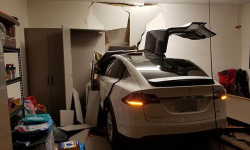
— A Tesla sudden unintended acceleration lawsuit is in full swing in a California courtroom as the plaintiffs allege Tesla Model S and Model X vehicles are prone to unintended acceleration that is the result of design defects that allow the vehicles to crash head-on into fixed objects.
Although the Tesla lawsuit now includes multiple plaintiffs, the suit was originally filed by Ji Chang Son, 46, a South Korean celebrity who lives in California. The plaintiff claims he was returning home with his son when the Tesla Model X slowed to about 6 mph while turning into the driveway to pull into the garage.
The lawsuit alleges the Model X accelerated at full power and crashed through the interior wall of the garage, destroying everything in the path of the SUV and finally stopping in the living room.
Both occupants were allegedly trapped inside the SUV because wooden support beams were blocking the doors, all while smoke was flowing into the vehicle. Believing the SUV was going to go up in flames, Kyung Min Son crawled out a window and ran to the other side to help his father escape.
According to the lawsuit, a study conducted by the National Highway Traffic Safety Administration of unintended acceleration reports from 2000 to 2010 shows one unintended acceleration event per 100,000 vehicles per year.
By comparison, within the first year of 18,240 Tesla Model X SUVs being on the roads, there have been 13 reported incidents of sudden unintended acceleration. The plaintiffs claim this equals 71 acceleration events per 100,000 vehicles per year.
However, the big topic about the Tesla lawsuit is how the plaintiffs look at unintended acceleration events. Affected owners say even if they accidentally press the gas pedals to the floorboards, the vehicles should not accelerate and crash.
"Irrespective of whether the SUA [sudden unintended acceleration] events in the Tesla vehicles are caused by mechanical issues with the accelerator pedal, an unknown failure in the electronic motor control system, a failure in other aspects of the electrical, mechanical, or computer systems, or some instances of pedal misapplication, the Model S and Model X are defective and unsafe."
The argument behind that thinking is that Tesla equips all its Model X vehicles, and has equipped its Model S vehicles since March 2015, with automatic emergency braking where the computer will use the cameras and the radar sensors to determine the distance from objects in front of the vehicles.
When a frontal collision is considered unavoidable, the system is designed to automatically apply the brakes to reduce the impact. But the plaintiffs claim Tesla has programmed the system to deactivate when it receives instructions from the accelerator pedal to drive full speed into a fixed object.
According to the lawsuit, Tesla's automatic emergency braking operates when driving between 5 mph to 85 mph, but in some circumstances the system will not automatically apply the brakes or will completely stop applying the brakes.
There allegedly won't be any braking “in situations where you are taking action to avoid a potential collision. For example: • You turn the steering wheel sharply. • You press the accelerator pedal. • You press and release the brake pedal. • A vehicle, motorcycle, bicycle, or pedestrian, is no longer detected ahead.”
Based on court documents, the plaintiffs say automatic emergency braking won't work when the computer believes the driver is commanding full throttle acceleration directly into fixed objects immediately in front of the vehicle. This is especially dangerous because the vehicles are capable of accelerating from 0 to 60 mph in 2.9 seconds.
Even with reports of Model S and Model X drivers hitting frontal objects, Tesla has allegedly failed to create and install computer algorithms that would prevent a driver from slamming into fixed objects and instead blames drivers for the incidents.
Obviously, Tesla sees things very differently and has asked the court to dismiss the sudden unintended acceleration lawsuit. To start, the automaker wants the court to dismiss 13 of the 27 claims for violations of consumer protection statutes, breaches of warranty and contract and product liability.
Saying the claims are "fatally defective," Tesla argues express warranty claims should be dismissed because the lawsuit alleges design defects exist with Tesla’s entire fleet of vehicles and not a defect in “materials or workmanship” covered by Tesla’s express Basic Vehicle Limited Warranty. According to the lawsuit, courts have routinely held that such warranties do not cover design defects.
In addition, the plaintiffs claim they were misled by marketing claims, but Tesla says those claims fail because no plaintiff can prove he ever read or saw any of the alleged statements.
Tesla told the court the plaintiffs want the automaker to do something no automaker has ever done: “develop and implement computer algorithms that would eliminate the danger of full throttle acceleration into fixed objects” even if they are caused by human errors.
Tesla says no automaker has a legal duty to design a failsafe car and on top of that, data from the plaintiff's vehicles shows each unintended acceleration incident was caused by the drivers, typically by hitting the gas pedals instead of the brake pedals.




